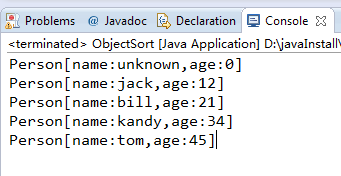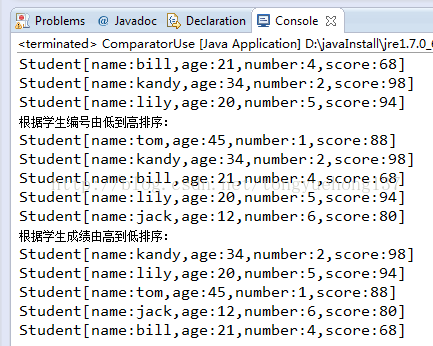JAVA中Arrays.sort()使用两种方式(Comparable和Comparator接口)对对象或者引用进行排序
一、描述
自定义的类要按照一定的方式进行排序,比如一个Person类要按照年龄进行从小到大排序,比如一个Student类要按照成绩进行由高到低排序。
这里我们采用两种方式,一种是使用Comparable接口:让待排序对象所在的类实现Comparable接口,并重写Comparable接口中的compareTo()方法,缺点是只能按照一种规则排序。
另一种方式是使用Comparator接口:编写多个排序方式类实现Comparator接口,并重写新Comparator接口中的compare()方法,在调用Arrays的sort()时将排序类对象作为参数传入:public static
优点是可以按照多种方式排序,你要按照什么方式排序,就创建一个实现Comparator接口的排序方式类,然后将该排序类的对象传入到Arrays.sort(待排序对象,该排序方式类的对象)
二、源代码
方式1:使用Comparable接口
package tong.day4_27.systemUse;
import java.util.Arrays;
/**
* 使用Comparable接口:让待排序对象所在的类实现Comparable接口,并重写Comparable接口中的compareTo()方法
* 缺点是只能按照一种规则排序
* @author tong
*
*/
public class ObjectSort {
public static void main(String[] args) {
Person[] persons = new Person[5];
persons[0] =new Person("tom",45);
persons[1] =new Person("jack",12);
persons[2] =new Person("bill",21);
persons[3] =new Person("kandy",34);
persons[4] =new Person();
Arrays.sort(persons);
for (Person person:persons) {
System.out.println(person);
}
}
}
class Person implements Comparable{
private String name;
private int age;
public Person(String name,int age){
this.name = name;
this.age = age;
}
public Person(){
this("unknown", 0);
}
//重写该类的compareTo()方法,使其按照从小到大顺序排序
@Override
public int compareTo(Person o) {
return age-o.age;
}
//重写Student类的toString()方法,在输入对象时按照以下方式输出
@Override
public String toString() {
return "Person[name:"+name+",age:"+age+"]";
}
} 方式2:使用Comparator接口
package tong.day4_27.systemUse;
import java.util.Arrays;
import java.util.Comparator;
/**
* 使用Comparator接口:编写多个排序方式类实现Comparator接口,并重写新Comparator接口中的compare()方法
* public static void sort(T[] a,Comparator c),根据指定比较器产生的顺序对指定对象数组进行排序。数组中的所有元素都必须是通过指定比较器可相互比较的
* (也就是说,对于数组中的任何 e1 和 e2 元素而言,c.compare(e1, e2) 不得抛出 ClassCastException)。
* 优点是可以按照多种方式排序,你要按照什么方式排序,就创建一个实现Comparator接口的排序方式类,然后将该排序类的对象传入到Arrays.sort(待排序对象,该排序方式类的对象)
* @author tong
*
*/
public class ComparatorUse {
public static void main(String[] args) {
Student[] persons = new Student[5];
persons[0] =new Student("tom",1,88,45);
persons[1] =new Student("jack",6,80,12);
persons[2] =new Student("bill",4,68,21);
persons[3] =new Student("kandy",2,98,34);
persons[4] =new Student("lily",5,94,20);
System.out.println("排序前的数据:");
for (Student student:persons) {
System.out.println(student);
}
//创建SortByNumber对象,将其作为参数传入Arrays.sort(persons,sortByNumber)方法中
SortByNumber sortByNumber = new SortByNumber();
Arrays.sort(persons,sortByNumber);
System.out.println("根据学生编号由低到高排序:");
for (Student student:persons) {
System.out.println(student);
}
SortByScore sortByScore = new SortByScore();
Arrays.sort(persons,sortByScore);
System.out.println("根据学生成绩由高到低排序:");
for (Student student:persons) {
System.out.println(student);
}
}
}
class Student {
private String name;
private int number;
private int score;
private int age;
public Student(String name,int number,int score,int age){
this.name = name;
this.number = number;
this.score = score;
this.age = age;
}
//重写Student类的toString()方法,在输入对象时按照以下方式输出
@Override
public String toString() {
return "Student[name:"+name+",age:"+age+",number:"+number+",score:"+score+"]";
}
public String getName() {
return name;
}
public void setName(String name) {
this.name = name;
}
public int getNumber() {
return number;
}
public void setNumber(int number) {
this.number = number;
}
public int getScore() {
return score;
}
public void setScore(int score) {
this.score = score;
}
public int getAge() {
return age;
}
public void setAge(int age) {
this.age = age;
}
}
//按照学号由低到高排列,创建SortByNumber类,该类实现Comparator,重写该接口的compare()
class SortByNumber implements Comparator{
//重写该接口的compare()使其按照学号由小到大排序(前者减去后者)
@Override
public int compare(Student o1, Student o2) {
return o1.getNumber()-o2.getNumber();
}
}
//按照分数由高到低排列,创建SortByScore类,该类实现Comparator,重写该接口的compare()
class SortByScore implements Comparator{
//重写该接口的compare()使其按照分数由高到低排序(后者减去前者)
@Override
public int compare(Student o1, Student o2) {
return o2.getScore()-o1.getScore();
}
} 
